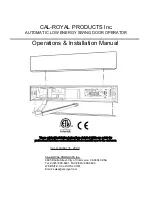
METHODS OF REDUCING EMISSIONS
Mains supply
Welding equipment should be connected to the mains supply according to the manufacturers recommendations. If interference
occurs, it may be necessary to take additional precautions such as filtering of the mains supply. Consideration should be given
to shielding the supply cable of permanently installed welding equipment, in metallic conduit or equivalent. Shielding should be
electrically continuous throughout its length. The shielding should be connected to the welding power source so that good
electrical contact is maintained between the conduit and the welding power source enclosure.
Maintenance of the welding equipment
The welding equipment should be routinely maintained according to the manufacturers recommendations. All access and
service doors and covers should be closed and properly fastened when the welding equipment is in operation. The welding
equipment should not be modified in any way except for those changes and adjustment covered in the manufacturers
instructions. In particular, the spark gaps of arc striking and stabilizing devices should be adjusted and maintained according to
the manufacturers recommendations.
Welding cables
The welding cables should be kept as short as possible and should be positioned close together, running at or close to the floor
level.
SECTION 1 --- SAFETY
1.1 INTRODUCTION
Arc welding processes as developed after many years of welding experience can be used with a high degree of safety provided
that proper care and attention is given to common sense practices and to manufacturer’s recommended methods.
It is therefore imperative that management and safety personnel make sure that all personnel who will operate or maintain the
welding equipment be given the opportunity to read this information.
1.2 GENERAL PRECAUTIONS
1.2.1 Prevention of burns
Sparks, slag, hot metal and radiations produced by the welding arc can be seriously damaging to the eyes and skin. As the
operator or any other person comes close to the welding area, the level of exposure increases rapidly. Proper protective clothing
and equipment must be worn by the operator and any other persons working in the vicinity of the arc. Gauntlet gloves designed
for use in welding, safety shoes, and a hat are required. Flame retardant clothing which covers all exposed areas and cuffless
trousers to prevent entry of sparks and slag are recommended. Proper safety goggles or glasses with side shields of the
appropriate welding lens shade MUST be worn to protect the operator’s eyes from radiant energy and flying sparks or hot metal.
1.2.2 Fire prevention
Since electric welding arc produces hot metal, sparks, and slag, precautions must be taken to prevent fire and/or explosions.
Make sure that appropriate fire extinguishing equipment is available in the immediate welding area.
All combustible materials must be removed from the immediate welding area to a distance of at least 10 meters(35 feets) away.
Never arc weld empty containers which have held toxic or potentially explosive materials. Those containers must be thoroughly
cleaned prior to welding.
Never arc weld in an atmosphere which contains heavy concentrations of dust, flammable gas, or combustible liquid
vapors(such as gasoline).
After each welding operation make sure to let welded material to cool down before touching it or putting it in contact with
combustible or flammable materials.
1.2.3 Toxic Fumes
Proper precautions must be exercised to prevent the exposure of the operator or others in the surrounding area to possible toxic
fumes which may be generated during electric are welding.
Certain chlorinated solvents will decompose under ultraviolet radiations to form phosgene gas. Care must be exercised to avoid
the use of these solvents on materials being weld with electric arc welding equipment. Containers of these solvents and other
degreasing agents must be removed from the immediate area near the welding arc.
Metals coated with or containing significant amounts of lead, cadmium, zinc, mercury, and beryllium can produce harmful
concentration of toxic fumes when subject to electric arc welding operations. Adequate local exhaust ventilation must be used or
the operator must be wearing special equipment to guarantee a supply of fresh air as a respirator or air supplied helmet.
Do not weld metals coated with materials which emit toxic fumes unless 1) the coating is removed prior to welding, 2) the area is
adequately ventilated, or 3) the operator is supplied with fresh-air breathing equipment.
1.2.4 Radiation
Ultra-violet radiations created by the arc may be harmful to the eyes and burn the skin; it is therefore imperative to wear
protective clothing and helmet.
Contact lenses should not be used as the intense heat coming from the arc may cause them to stick to the cornea.
The mask used during welding should be equipped with grade DIN 10 safety lenses at least and they should immediately be
replaced whenever damaged or broken.
Since the arc may damage the eyes it is considered dangerous up to a distance of 15 meters (50 feets) and it should never be
locked at with the naked eye.
4





































